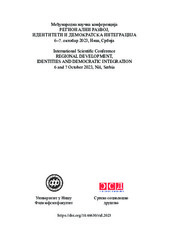Приказ основних података о документу
The Economic Position of Urban and Rural Population in Serbia During the Consolidation of Capitalism
| dc.contributor | Božilović, Jelena | |
| dc.contributor | Stanojević, Nenad | |
| dc.creator | Manić, Željka | |
| dc.date.accessioned | 2023-12-25T15:13:50Z | |
| dc.date.available | 2023-12-25T15:13:50Z | |
| dc.date.issued | 2023 | |
| dc.identifier.isbn | 978-86-7379-628-4 | |
| dc.identifier.uri | http://reff.f.bg.ac.rs/handle/123456789/5881 | |
| dc.description.abstract | The subject of this paper is an analysis of the economic position of the urban and rural population in Serbia during the consolidation of the capitalist order. The main objective is to determine whether there have been significant differences in the economic position of these social groups in the specified period, and the assumption is that they exist. An additional objective is an analysis of the economic position of the urban and rural population in Serbia over two decades, starting from the accelerated post-socialist transformation to the consolidation of capitalism, and the assumption is that the economic position of the urban population is higher than the position of the rural population regardless of the variations in the stability of the emerging capitalist order. The analysis is based on data from a survey conducted in 2018 on a representative sample of the Serbian population of 2,211 respondents. In addition, data from comparable surveys from 2003 and 2012 are used, and all three were conducted by the Institute for Sociological Research of the Faculty of Philosophy in Belgrade. First are analysed the indicators of the basic dimensions of the economic position, i.e. income, property and consumption of the urban and rural population in Serbia. Then the overall economic position was analyzed, which is expressed by a composite index shown in the form of an interval scale with five levels of economic position: lower, lower middle, medium, upper middle and higher material position. The analysis of the indicators of the basic dimensions, and the overall economic position showed that the economic position of the urban population in Serbia during the consolidation of capitalism is significantly higher than the position of the rural population, i.e. that the economic position of the urban population is higher in all three time periods. | sr |
| dc.language.iso | en | sr |
| dc.publisher | Univerzitet u Nišu, Filozofski fakultet, Srpsko sociološko društvo | sr |
| dc.relation | Рад на тексту је подржало Министарство науке, технолошког развоја и иновација Републике Србије у склопу финансирања научноистраживачког рада Универзитета у Београду – Филозофског факултета (број уговора 451-03- 47/2023-01/200163). | sr |
| dc.rights | openAccess | sr |
| dc.rights.uri | https://creativecommons.org/licenses/by/4.0/ | |
| dc.source | Regional Development, Identities and Democratic Integration | sr |
| dc.subject | economic position | sr |
| dc.subject | urban population | sr |
| dc.subject | rural population | sr |
| dc.subject | Serbia | sr |
| dc.subject | consolidation of capitalism | sr |
| dc.title | The Economic Position of Urban and Rural Population in Serbia During the Consolidation of Capitalism | sr |
| dc.type | conferenceObject | sr |
| dc.rights.license | BY | sr |
| dc.rights.holder | Univerzitet u Nišu, Filozofski fakultet, Srpsko sociološko društvo | sr |
| dc.identifier.fulltext | http://reff.f.bg.ac.rs/bitstream/id/14836/Knjiga_rezimea.pdf | |
| dc.identifier.rcub | https://hdl.handle.net/21.15107/rcub_reff_5881 | |
| dc.type.version | publishedVersion | sr |

